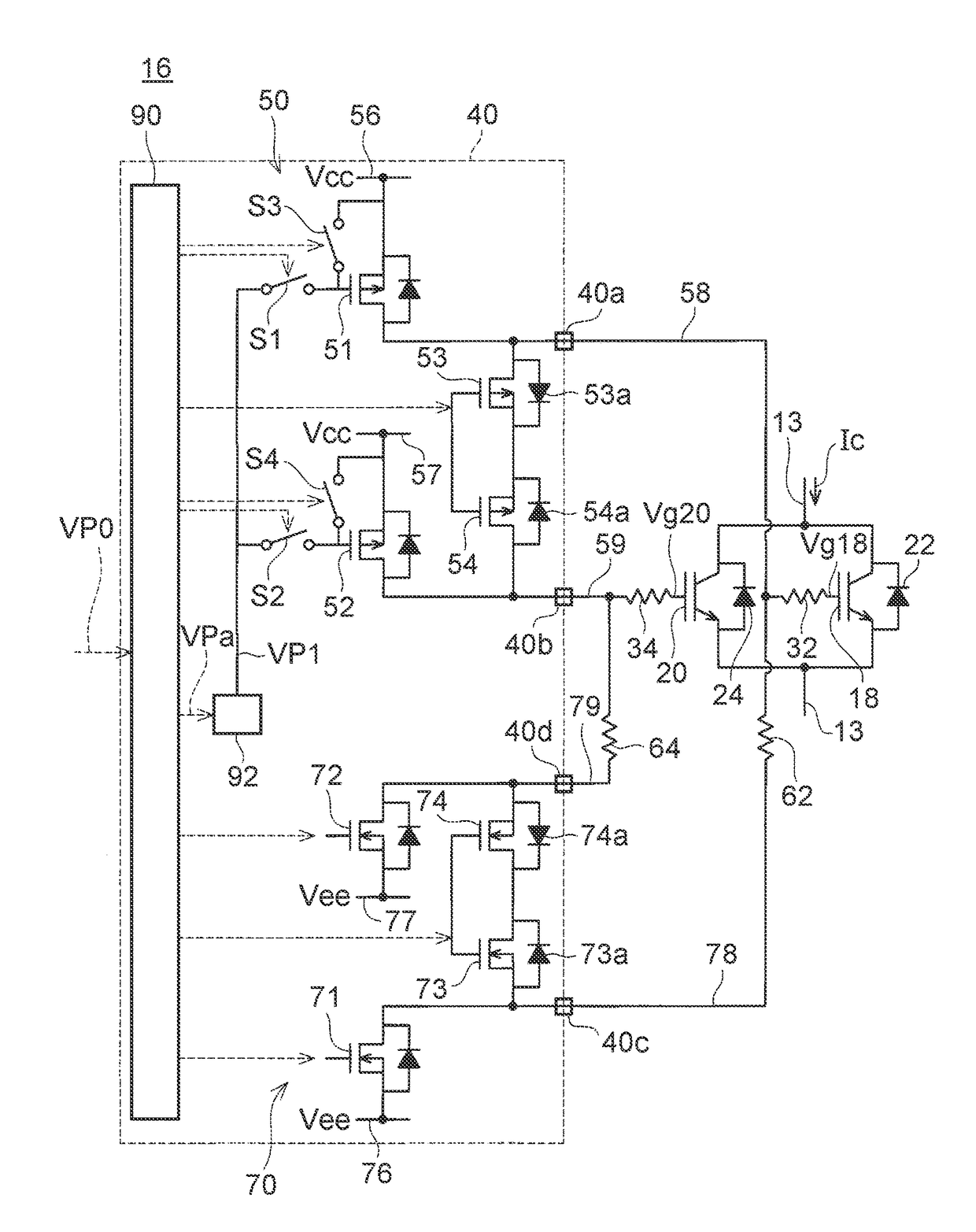Switching circuit
a technology of switching circuit and switch, which is applied in the direction of electronic switching, dc-ac conversion without reversal, pulse technique, etc., can solve the problems of difficult to reduce the turn-off loss of the igbt, the switching speed and the turn-off loss are not established, and the switch speed is increased. , to achieve the effect of reducing gate resistance, reducing turn-off loss, and increasing the switching speed of the igb
- Summary
- Abstract
- Description
- Claims
- Application Information
AI Technical Summary
Benefits of technology
Problems solved by technology
Method used
Image
Examples
first embodiment
[0032]The inverter circuit 10 in the disclosure shown in FIG. 1 supplies an alternating current to a running motor 98 of a vehicle. The inverter circuit 10 has a high-potential wiring 12 and a low-potential wiring 14. The high-potential wiring 12 and the low-potential wiring 14 are connected to a direct-current electric power supply (not shown). A high potential VH is applied to the high-potential wiring 12, and a low potential VL is applied to the low-potential wiring 14. Three series circuits 15 are connected in parallel between the high-potential wiring 12 and the low-potential wiring 14. Each of the series circuits 15 has a connection wiring 13 that is connected between the high-potential wiring 12 and the low-potential wiring 14, and has two of the switching circuits 16 that are interposed in the connection wiring 13. The two switching circuits 16 are connected in series between the high-potential wiring 12 and the low-potential wiring 14. Output wirings 22a to 22c are connecte...
second embodiment
[0087]In the case where the current Ic is small, the switching circuit according to the disclosure executes the unilateral control procedure as shown in FIG. 5. That is, in the case where the current Ic is small, the logic circuit 90 controls the IGBT's 18 and 20 such that an on period Ton18 when only the IGBT 18 turns on and an on period Ton20 when only the IGBT 20 turns on alternately emerge. More specifically, the logic circuit 90 performs control such that the on period Ton18, the off period Toff, the on period Ton20 and the off period Toff repeatedly emerge in this sequence. In the off period Toff, both the IGBT 18 and the IGBT 20 are off. For example, the logic circuit 90 determines at a timing t1 in FIG. 5 that the current Ic is smaller than the threshold Ith in the immediately preceding on period Ton20. Then, in the subsequent on period Ton18, the logic circuit 90 turns on the IGBT 18 and holds the IGBT 20 off. Since the current Ic has not risen to the threshold Ith in this ...
third embodiment
[0094]In the aforementioned control, while the IGBT 20 turns off at the timing tc, the IGBT 18 is held on. Even when the IGBT 20 turns off, the IGBT 18 is on, so the voltage between the collector and emitter of the IGBT 20 is held equal to a low voltage. Accordingly, when the IGBT 20 turns off, no turn-off loss is caused. Besides, when the IGBT 18 turns off at the turn-off timing tf, the voltage between the collector and emitter of the IGBT 18 rises due to the turning off of the IGBT 18. Accordingly, the turn-off loss is caused at the turn-off timing tf. However, at the turn-off timing tf, the IGBT 18 turns off alone, so the turn-off loss is small. Accordingly, the switching circuit according to the disclosure also makes it possible to reduce the turn-off loss. Besides, even in the case where the current Ic is small as described hitherto, the loads applied to the IGBT's 18 and 20 can be further reduced by scattering the current Ic to the IGBT's 18 and 20 in part of the on period Ton...
PUM
 Login to View More
Login to View More Abstract
Description
Claims
Application Information
 Login to View More
Login to View More - R&D
- Intellectual Property
- Life Sciences
- Materials
- Tech Scout
- Unparalleled Data Quality
- Higher Quality Content
- 60% Fewer Hallucinations
Browse by: Latest US Patents, China's latest patents, Technical Efficacy Thesaurus, Application Domain, Technology Topic, Popular Technical Reports.
© 2025 PatSnap. All rights reserved.Legal|Privacy policy|Modern Slavery Act Transparency Statement|Sitemap|About US| Contact US: help@patsnap.com



